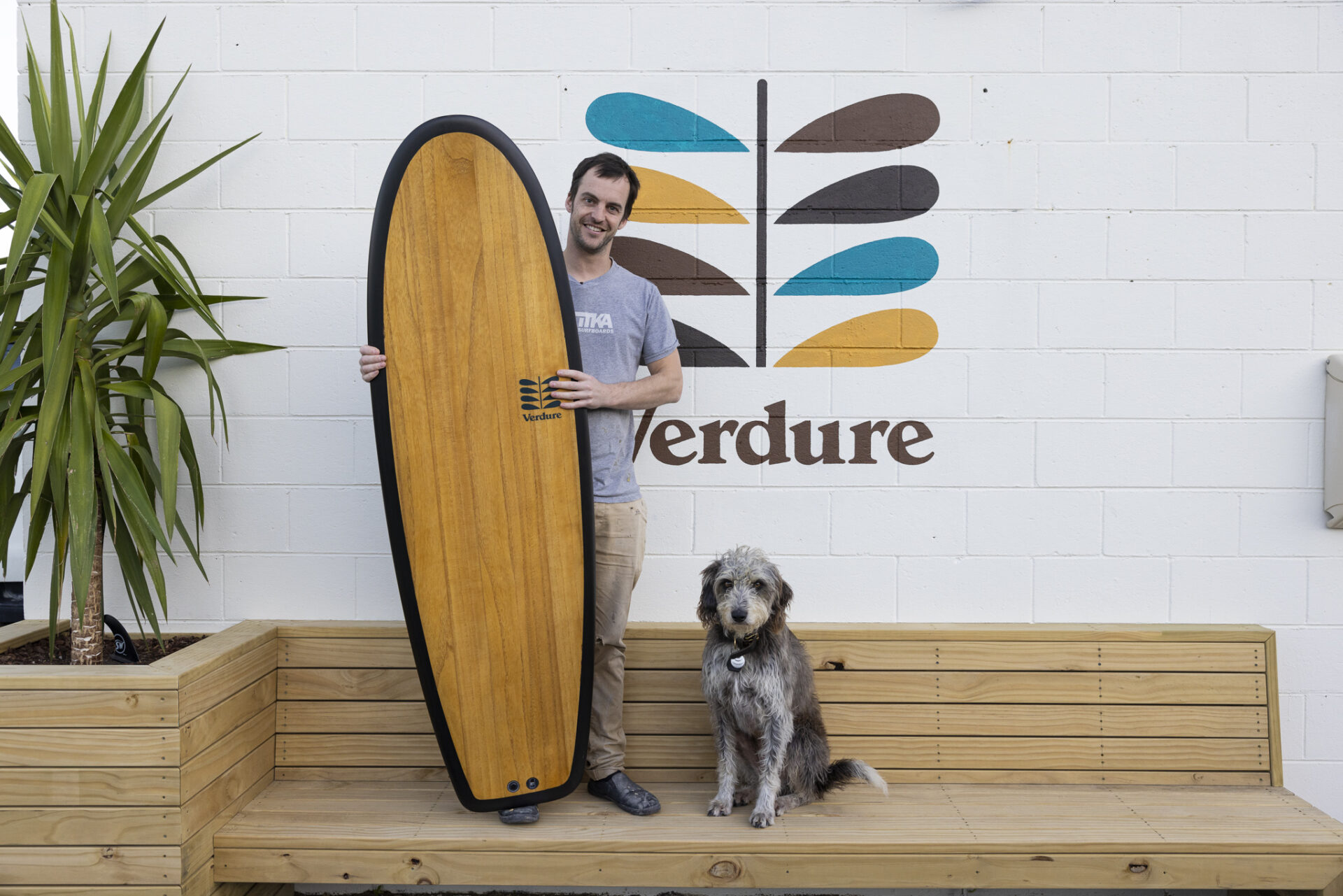Jack Candlish and team at Verdure Surf just might be the future of surfboard manufacturing. Operating on the cutting edge of sustainable surfboard development, they seem to have found accessible solutions to the environmental flaws plaguing the surf manufacturing industry. They’ve already won over top surfers and shapers, and they are still on the rise. NZSJ’s Taira Blakely sits down with Jack to learn about the movement … before they take over the surfing world.
Jack Candlish walks me through Verdure’s HQ in Lyall Bay, Wellington. The sweet natural smell of wood catches my attention – a stark contrast to the noxious fumes of most surfboard shaping facilities. So what gives?
“Each of our surfboards has a wood bottom, with a cork or wood deck,” Jack explains. He grabs one of his creations – a sleek wooden board with painted rails that looks more like an art piece than a surfboard. The natural grains of wood on the deck are on full display. This is the foundation that Verdure has built itself on – organic materials that are healthy for the earth, for shapers, and for surfers. But how do Jack’s boards stack up to traditional polyurethane (PU) and fibreglass construction surfboards? I wonder if Verdure has found the formula for sustainable performance surfboards?
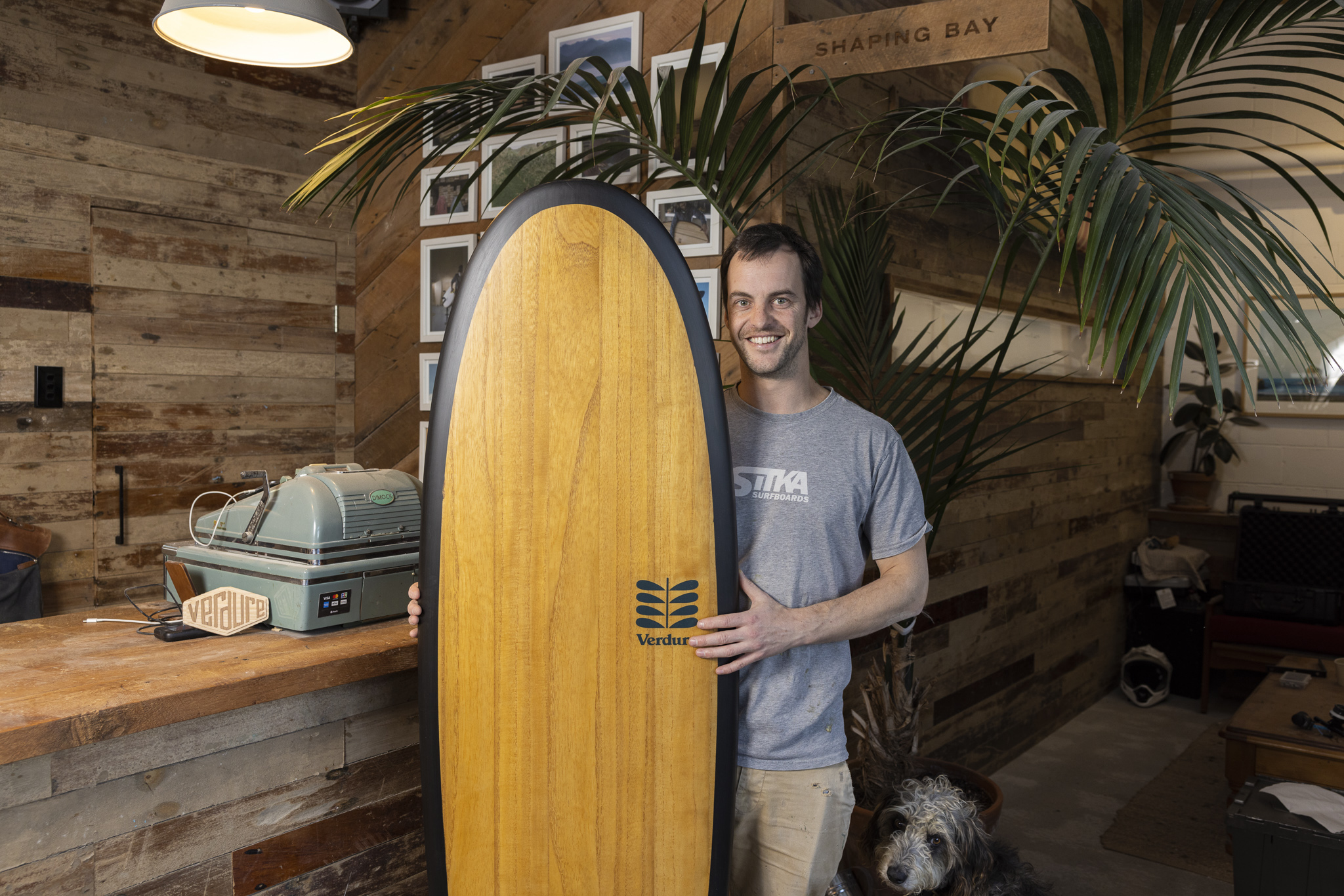
“It all started around 2013 or 2014, when I was working in this wood furniture workshop,” Jack begins. “At the time, I’d begun getting frustrated with the amount of repair work that I was doing on my polyurethane surfboards. I didn’t like the toxic chemicals I was working with either – they just weren’t aligned with what surfing was about for me. So I had the idea to craft a wooden board and see if I could make a more durable construction.”
Luckily, Jack’s wood furniture workshop turned out to be the perfect setup for making wooden surfboards.
“I literally just found a CAD file online, dissected it up and built this hollow board. That first one was pretty bad,” Jack laughs. “It was super heavy – but it was strong. And after that, I kept making boards for myself for about two years until eventually, I got something I was kind of happy with.”
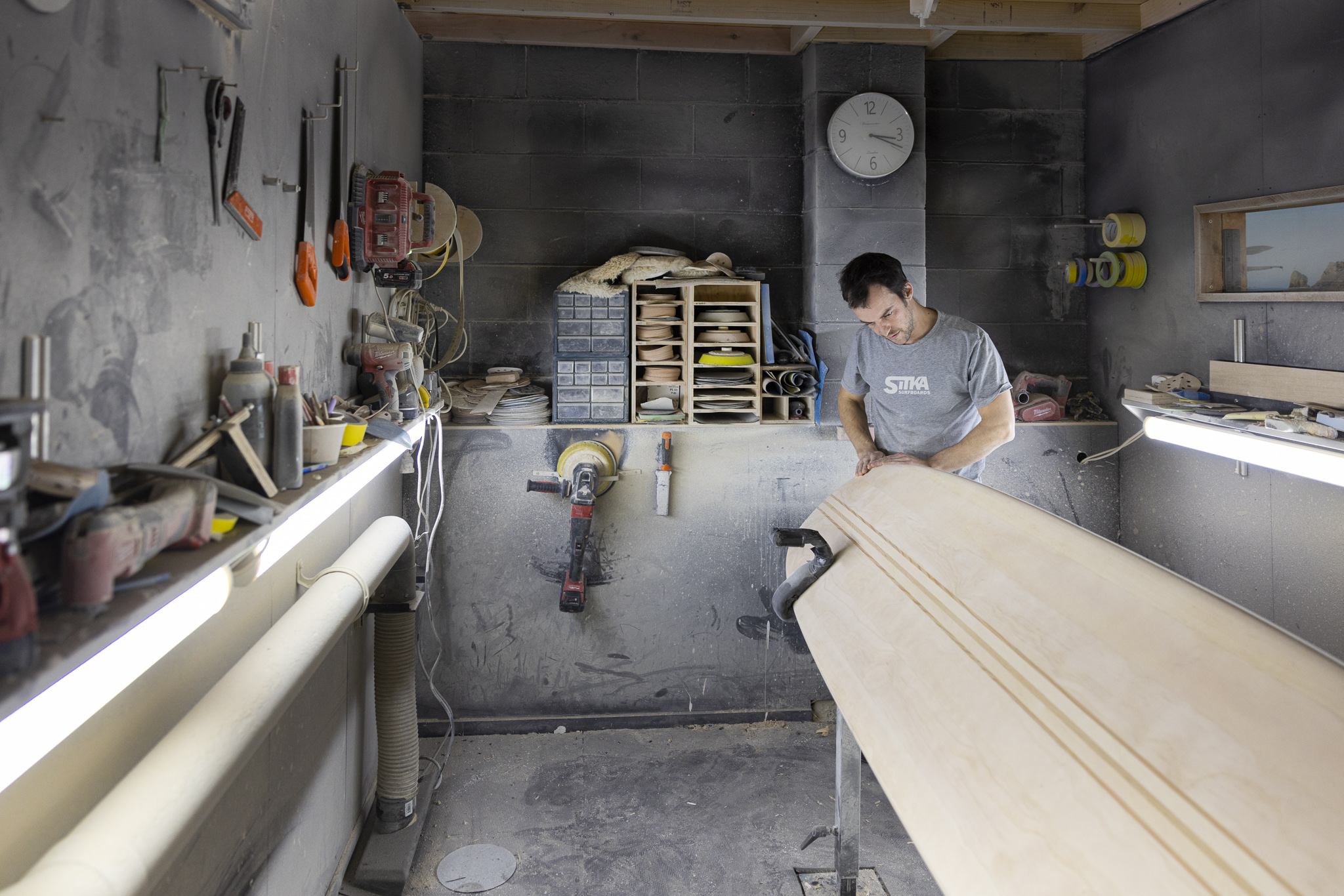
“Eventually I became interested in making more performance shapes. This was a massive challenge, because they had to weigh around three kilograms, which is about as heavy as you can go for a shortboard. At that weight, it was a real challenge making them strong enough,” Jack admits. “People would eventually put their foot through the deck. But eventually I learned to reinforce the boards with recycled polystyrene and was able to make boards that were super light and strong. And that was when I started to go full-time into producing these boards. At that point, I felt like they became commercially viable.”
Jack spent countless hours studying different shapes and rail profiles, and surfing his own boards in pursuit of that sweet spot. In 2017, just four years after teaching himself the basics of shaping and “messing around” as he’ll tell you, Jack started selling his boards. And in 2018, he left the furniture company to go full-time with surfboards, birthing his brand, Verdure Surf. If you saw his operation today, you would never guess that he’s self taught.
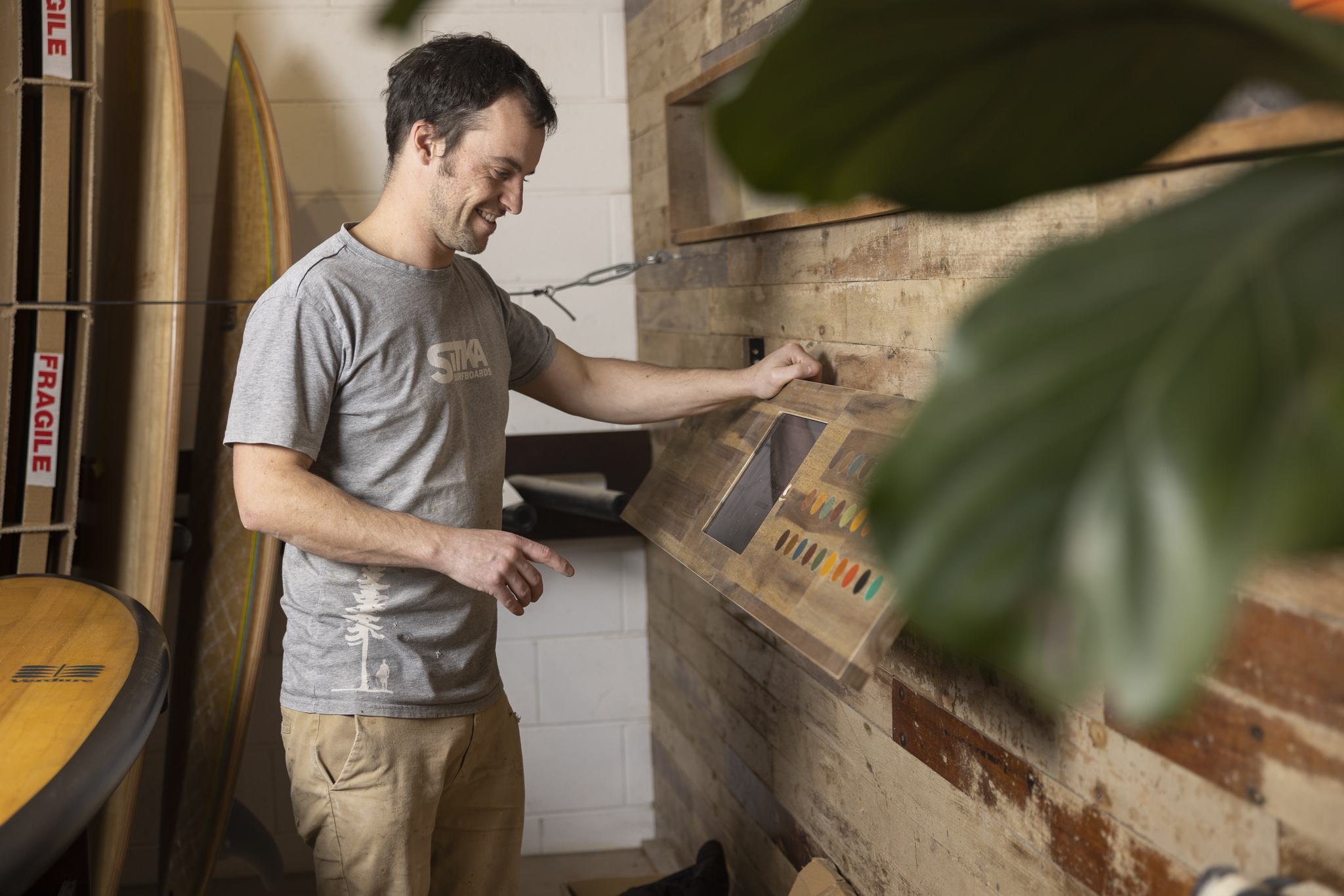
Jack’s shaping journey began in pursuit of a more durable surfboard construction using natural materials. Today, his business is much more than that. Jack has now mastered the art of the sustainable performance surfboard, and aims to fight against the environmentally unsafe practices of surfboard manufacturing on a larger scale. We walk through the shaping bay, coating bay, assembly area, and finally to a wall with about a dozen beautiful wooden and cork surfboards of all shapes and sizes. Jack grabs one and holds it up.
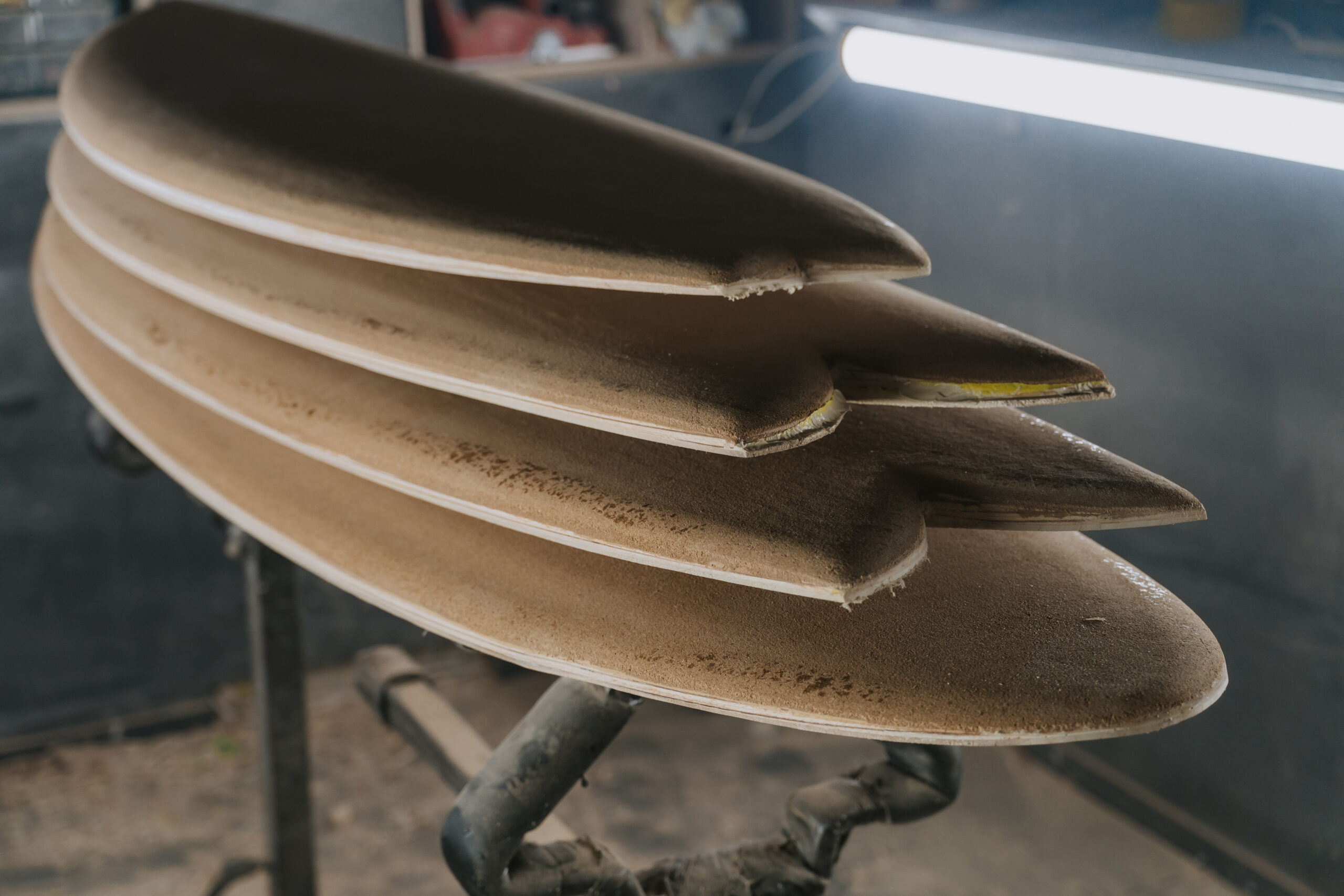
“As most people are aware, the majority of surfboards are produced from polyurethane foam blanks and glassed with fibreglass and polyester resin,” Jack explains. “I’m not trying to say there’s anything wrong with that construction – it provides good performance that can be domestically manufactured at a fair price point. To be honest, I’d say that’s the best option available right now to everyday surfers and shapers.”
“But the problem is that those materials are quite toxic. They expose shapers to harmful chemicals. And on top of that, often the boards don’t last well, depending on how well they’re glassed. If you want to make a three kilogram board using that construction method, most surfers will find that after about two years, those boards start to lose their pop. Then those materials aren’t able to be recycled or disposed of in a responsible manner. So they usually just either snap or crease and end up in a landfill where they don’t break down.”
This is one of the great contradictions within surf culture. Generally, surfers love the environment and want to do all they can to protect it. Sometimes it feels like we spend more time in the ocean than in our own homes. But environmentally friendly boards (especially those that perform well) are tough to acquire – especially locally. And for shapers? They are even tougher to create.
“There are a few companies, a majority of which are in Thailand, who are producing quite high tech constructions from materials that are less toxic and recyclable,” Jack continues. “But the barrier to entry of producing these boards is quite high. We’re talking huge factories with lots of machinery. Not really the type of manufacturing that local shapers are able to access. So essentially, I was most interested in bridging that gap and developing a solution that enabled the local shaper to produce high tech, lower environmental impact surfboards domestically. I had no idea how hard it would be,” he laughs. “But now we’ve got a good production system, and have even started licensing overseas.”
“I was most interested in bridging that gap and developing a solution that enabled the local shaper to produce high tech, lower environmental impact surfboards domestically.”
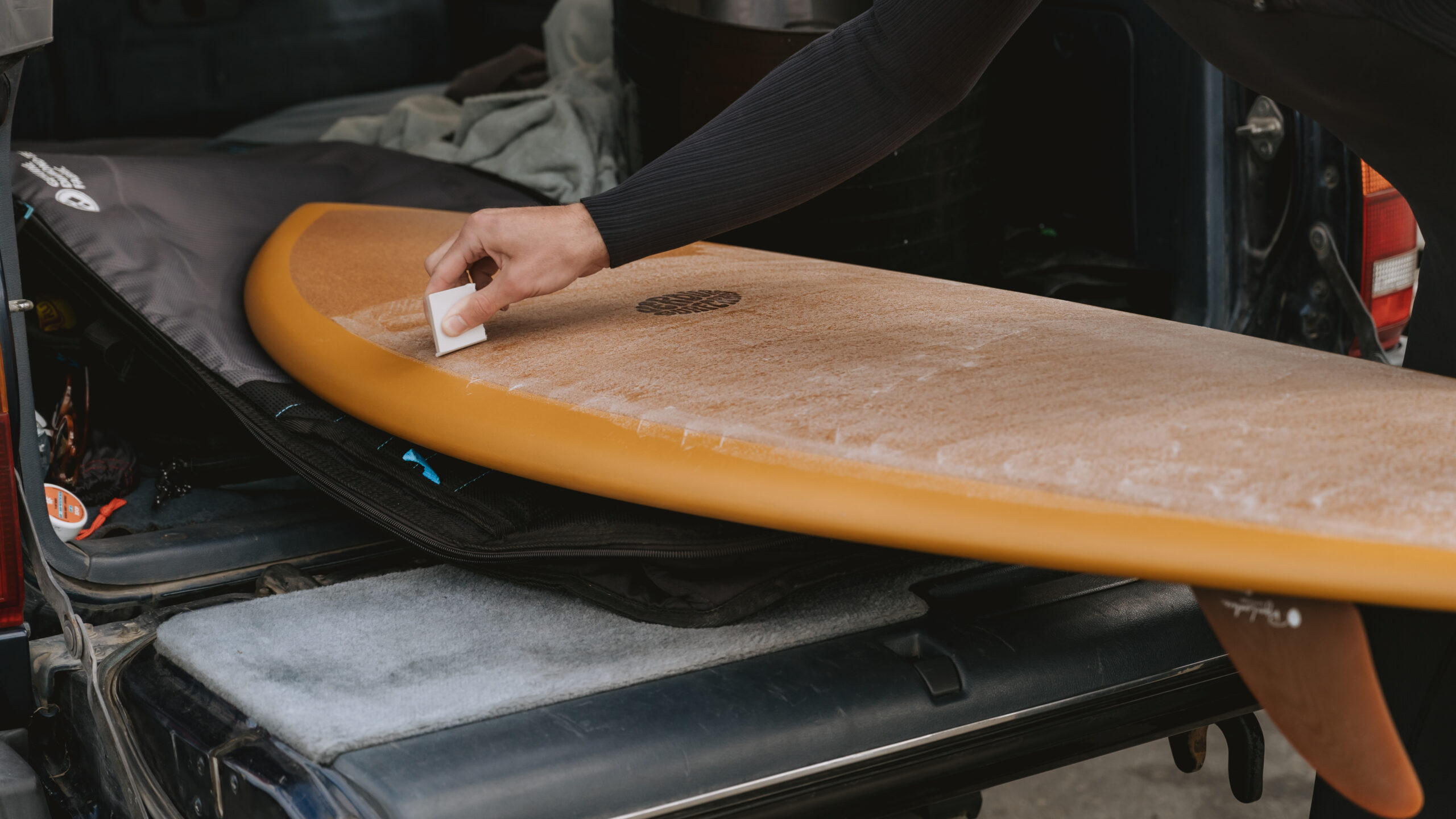
Jack has sure come a long way from his first hollow-wooden board and its stiff construction. Today, his boards are enjoyed by some of the best surfers on earth. But what does his production system look like in practice?
“Currently, in all of our boards, we’re using a locally-blown polystyrene core. It’s still a petroleum-based product and from an environmental perspective, is not the optimum material for a surfboard core,” Jack admits. “But one of the advantages that polystyrene has over polyurethane foam is that it can be recycled, and we do recycle our off-cuts. Polystyrene is also far less toxic than polyurethane foam, especially at the production point. Blowing PU foam releases loads of carcinogenic fumes. That was a huge part of why Clark Foam shut down in 2005, because two of the employees at the factory got cancer. I don’t think any surfer would want to ride a product that was associated with other surfers getting sick and dying from the materials that the boards are made from.”
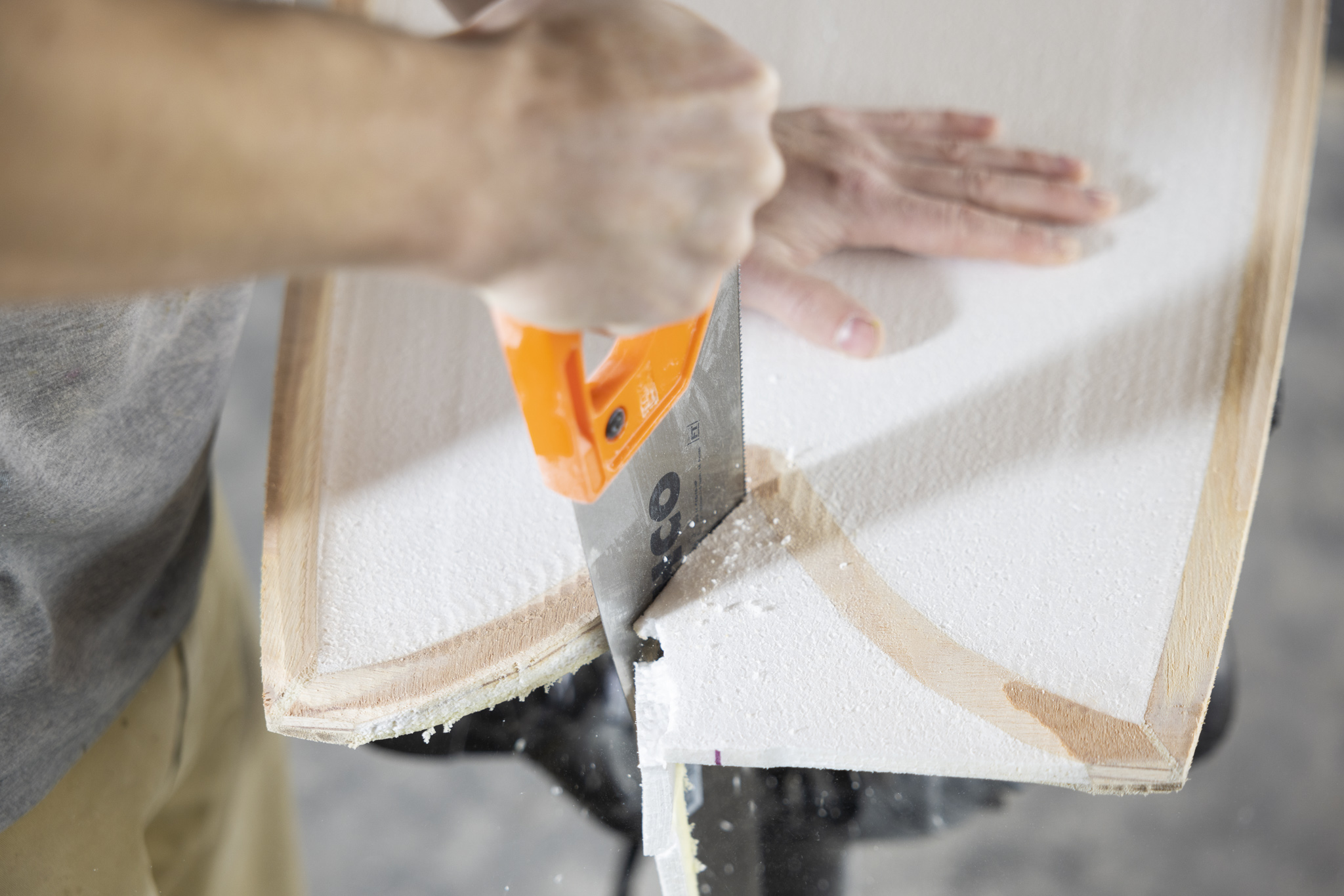
“We’ve also replaced fibreglass as a reinforcement with an organic acidified hemp fibre. We’ve replaced the toxic polyester resin with a plant-based epoxy. And instead of having a plywood stringer down the middle, we’ve developed these parabolic rails, which are essentially stacked plywood on the rails that allow for better and longer lasting flex.”
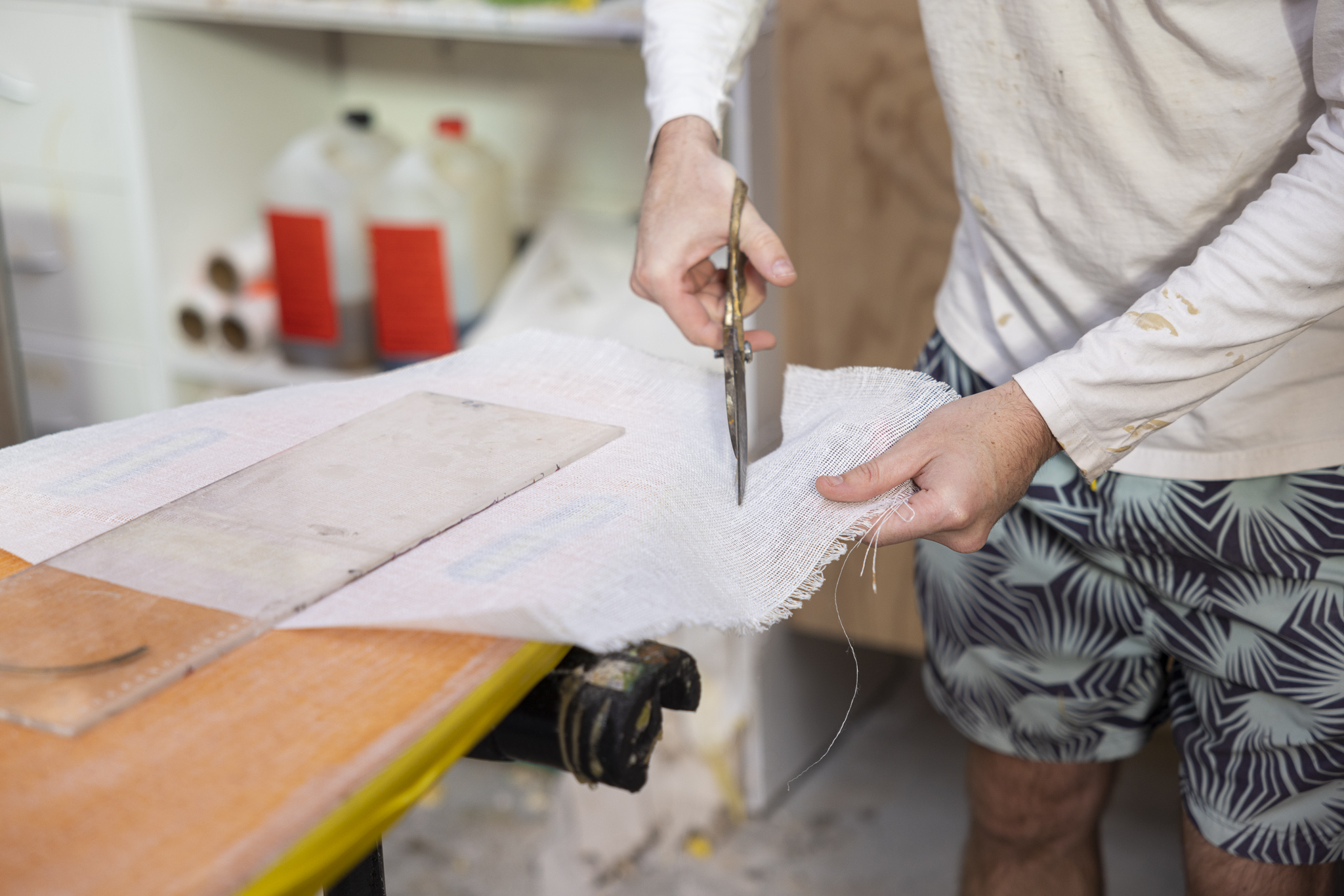
“On the outside of the boards, we put a layer of wood on the bottom and a layer of either cork or wood on the top, finishing the blank. Then we send that to a shaper, who does the finishing work and coats each board with a natural oil or hard wax. This waterproofs the board without having to use fibreglass and polyester resin, a process that requires sanding which can be quite toxic. So essentially it’s a conventional board with parabolic rails. And those extra materials on the outside provide great strength and are completely non-toxic. Unfortunately, our boards still have a bit of epoxy in the fin boxes, but overall it’s an entirely different product and a different production process compared to conventional methods.”
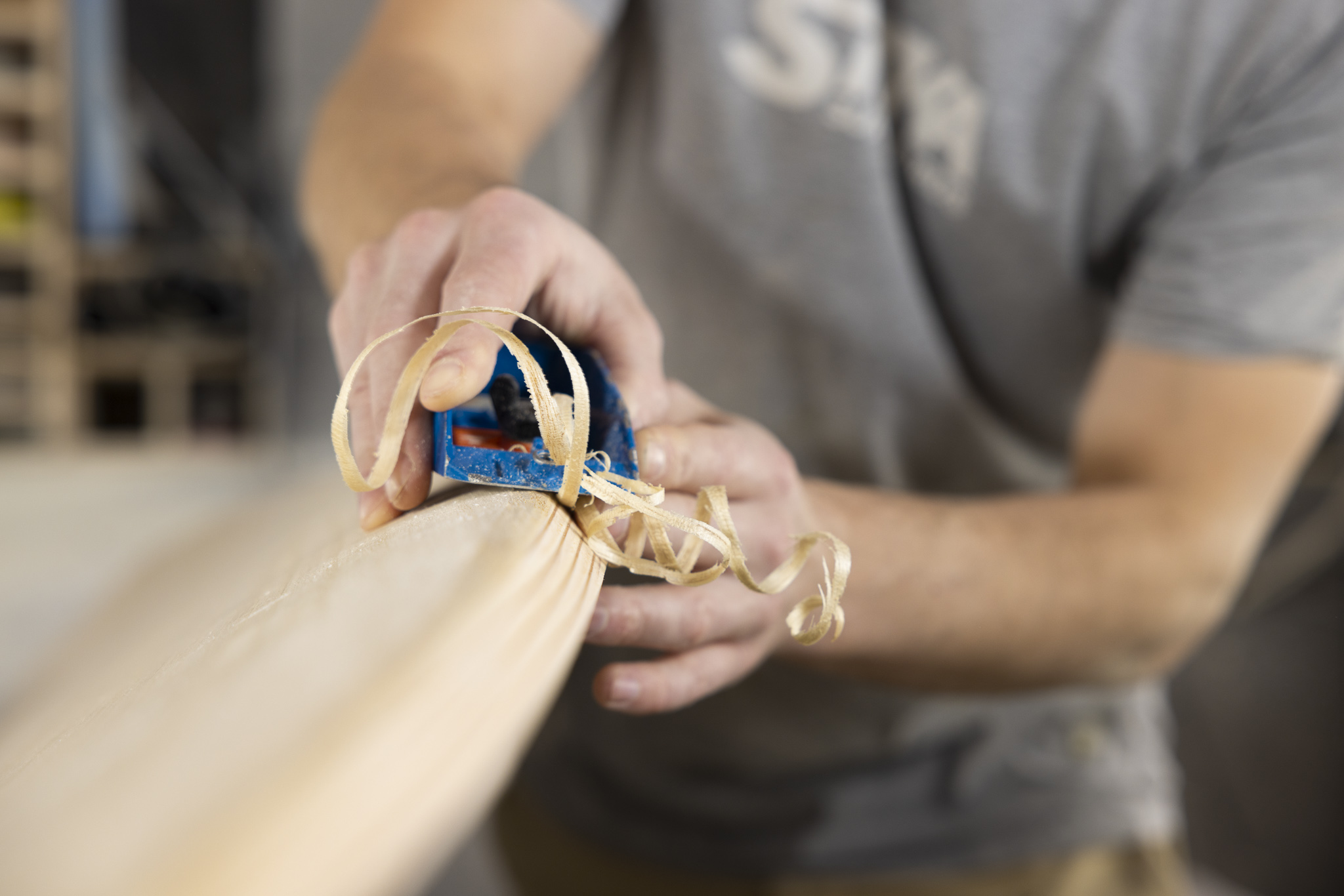
The boards sure look good. They’re gentle on the earth. And they’re healthier for shapers. But the big question is: how do Verdure surfboards perform in the water?
Jack will tell you that his construction is too newly developed to make any definitive claims. But early indicators suggest that compared to traditional PU boards, and in the right conditions, his boards are good. Very good. The parabolic rails that Jack mentioned improve the longevity and strength of each board and most importantly, provide an insane amount of flex. He reckons the flex that his boards have are what set his product apart, performance wise, compared to traditional PU boards.
“For performance short boards,” Jack explains, “your flex is pretty much the most important element when it comes to performance. It allows the surfer to store energy within the board and use it to project to the top of the wave. Our cork-top surfboards have got more flex than any other board that I’ve ever seen on the market,” he grins. “They’re insane.”
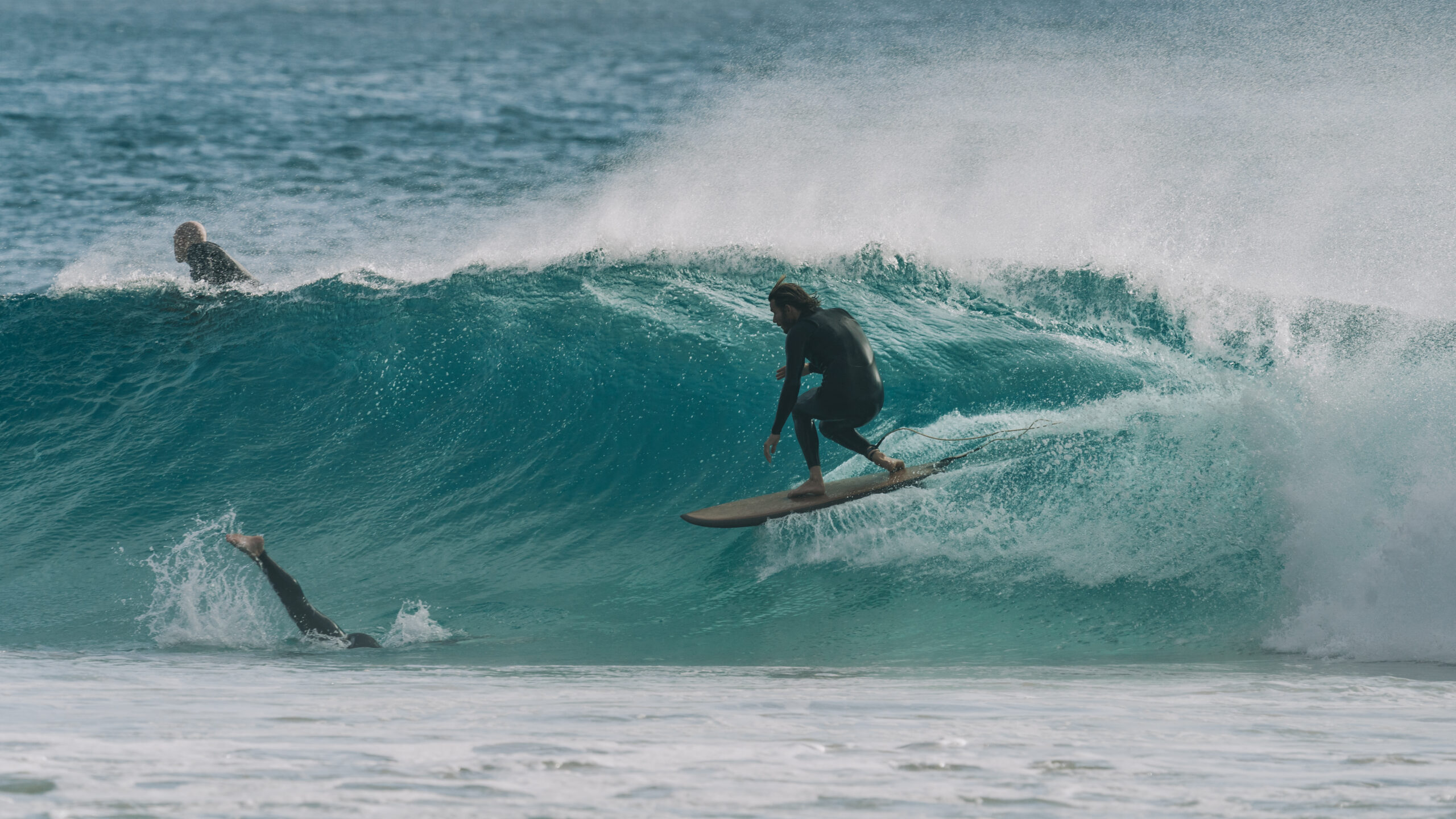
“Of course,” he continues, “that’s got pros and cons. What we’re learning is that in steep, powerful waves, a flexible board is much better. The reason for that is you’ve got an abundance of speed, and the board’s more often on rail. And so you can generate speed off your rail. But in smaller, fatter waves, they’ve got too much flex. That’s because you’re often surfing flat on the board and when the board flexes, it loses its rocker causing the board to go quite slow.”
So on those punchier days, Jack’s wood-bottom, cork-top construction will be great at providing the necessary flex to allow you to rip massive turns from top-to-bottom with confidence. But on those smaller days, he reckons his wood-bottom, wood-top boards are the better option.
“One issue with the full wood surfboard is that timber is all long-grain. This causes the boards to end up really stiff. That’s fine for logs and mid lengths – to an extent. If you’re just looking to cruise, wood’s great, and it doesn’t ding. I’m always really up front about that, so I do get quite frustrated when I hear people talking about wooden boards performing as well as PU … it’s just not possible,” Jack laughs.
“To be honest, I’d say that PU boards are still probably the best all-around construction. If someone wanted just one board for all conditions, I’d recommend PU. But if someone is mostly surfing steep powerful waves, then I’d say that our cork boards are the way to go.”
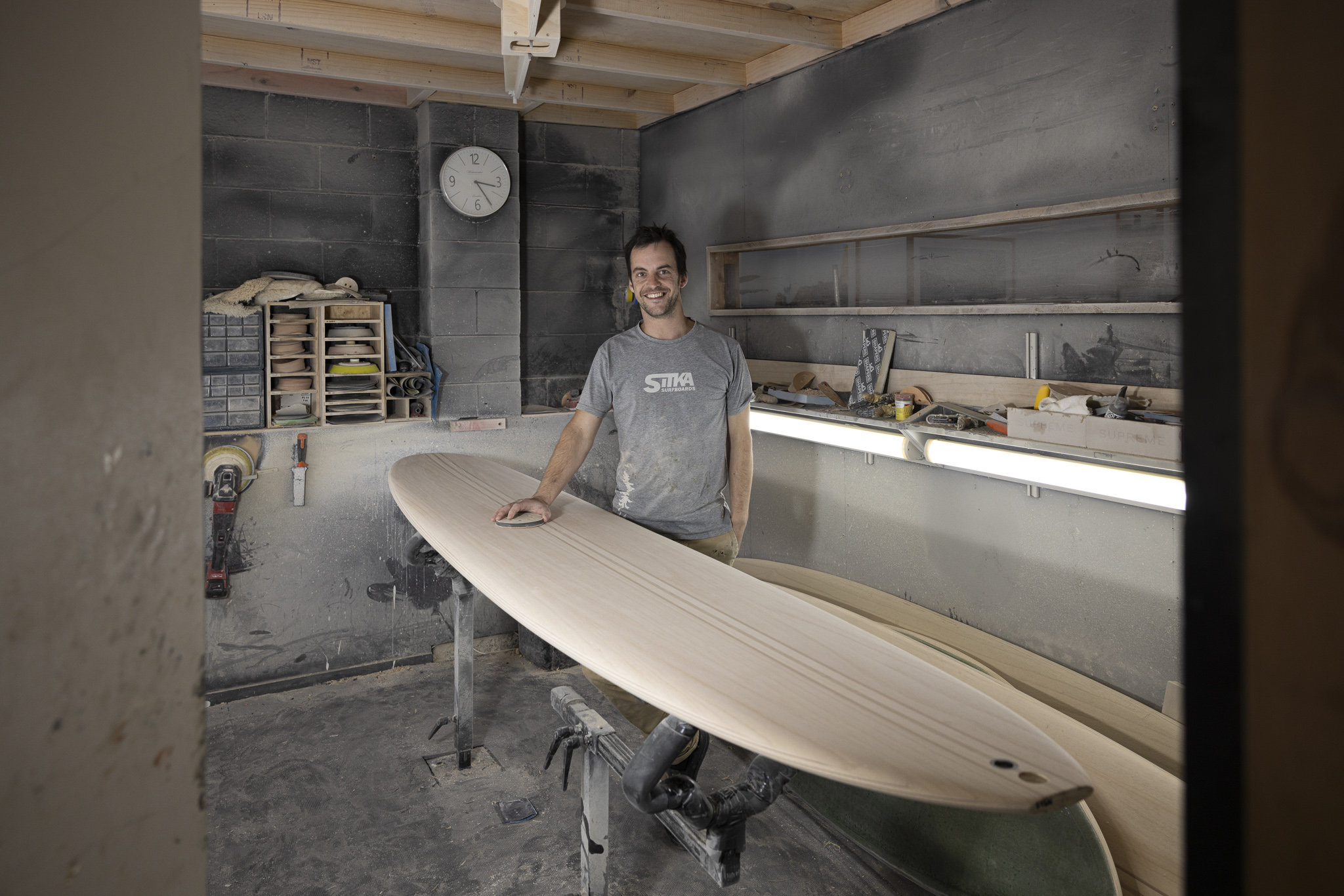
The average surfer might have a hard time appreciating the added performance that comes from Jack’s cork-top boards and their parabolic rails. But that flex really is no joke. In fact, top-level surfers have discovered that these boards might actually have a significant leg up on traditional PU construction boards.
“We’ve been fortunate enough to have some pretty good surfers on our boards at the moment. Tom Curren, three-time World Champion is riding one at the moment and he’s loving it. It’s all the flex, you know?” he laughs. “I’ve also been doing most of my product testing lately over in Byron Bay, Australia, and we’re lucky enough to be working with some of the best surfers over there. We get tons of great feedback from them.”
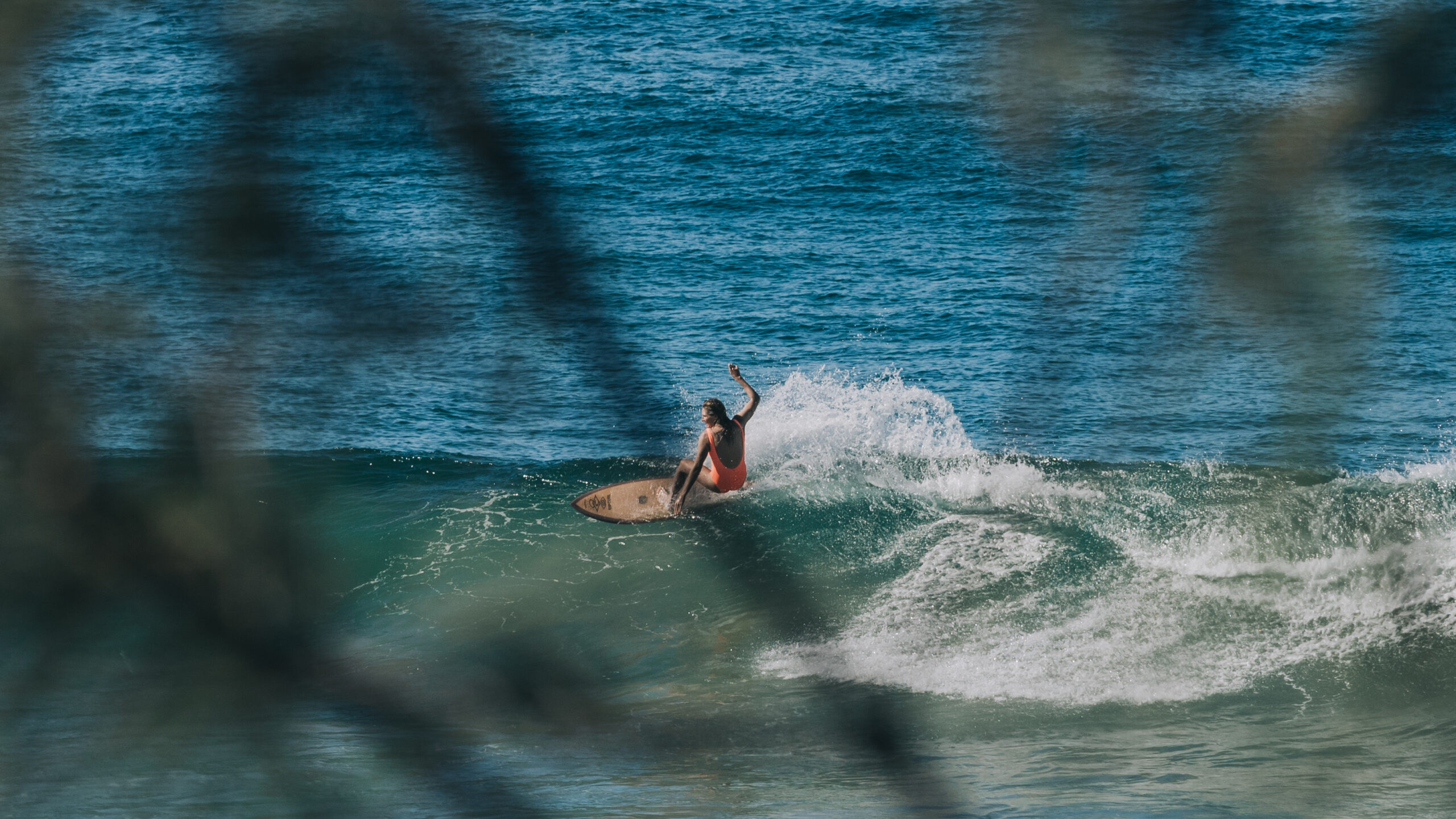
The flex is great. It’s what sets Jack’s surfboards apart, at least performance wise. But it isn’t everything – remember that natural oil that coats the outside of each board, providing natural waterproofing? Naturally, it’s extremely hydrophobic. It repels water so effectively that Jack believes it might actually make his surfboards faster than traditional boards.
“We use these plant-based oils to coat our boards. One of them is 100% VOC-free and is pretty much the most eco-friendly oil you can get. It’s insane.” He smiles. “And it smells amazing. That seals the wood and soaks in and protects it. Then we spray another 98% plant-based oil. Working together, they just repel water like crazy. When I hose them down, the water just blows off. We haven’t done any scientific testing yet, so I can’t say for certain how much our surface coating is affecting the speed of each board.” Jack pauses, and then grins. “But I have had top-level pro surfers complain about the boards being too fast.”
Now if that’s Verdure’s biggest performance critique, then something magical must be going on in that small factory of theirs in Lyall Bay. And from what he’s found so far, Jack reckons performance itself might not even be Verdure’s greatest strength. Instead, that would be their performance durability – the flex doesn’t subside with time like it does in traditional PU boards.
“I remember when I used to buy brand new PU boards, I would notice the boards getting a bit duller every month, and over time lose their pop,” Jack explains. “After about six months, they would feel a bit dead to me. And that’s usually when I’d sell it and buy another one.”
“It’s hard to say how long our boards really last because we’ve only been making them for ten years. But from all the feedback and what we’ve gathered, our boards tend to sustain the flex so they feel the same, performance wise, five to ten years from the day that they were purchased, which is pretty cool,” he smiles. “This also means that people are going to look after them and hold onto them for longer, keeping more boards out of the landfill.”
“From all the feedback and what we’ve gathered, our boards tend to sustain the flex so they feel the same, performance wise, five to ten years from the day that they were purchased.”
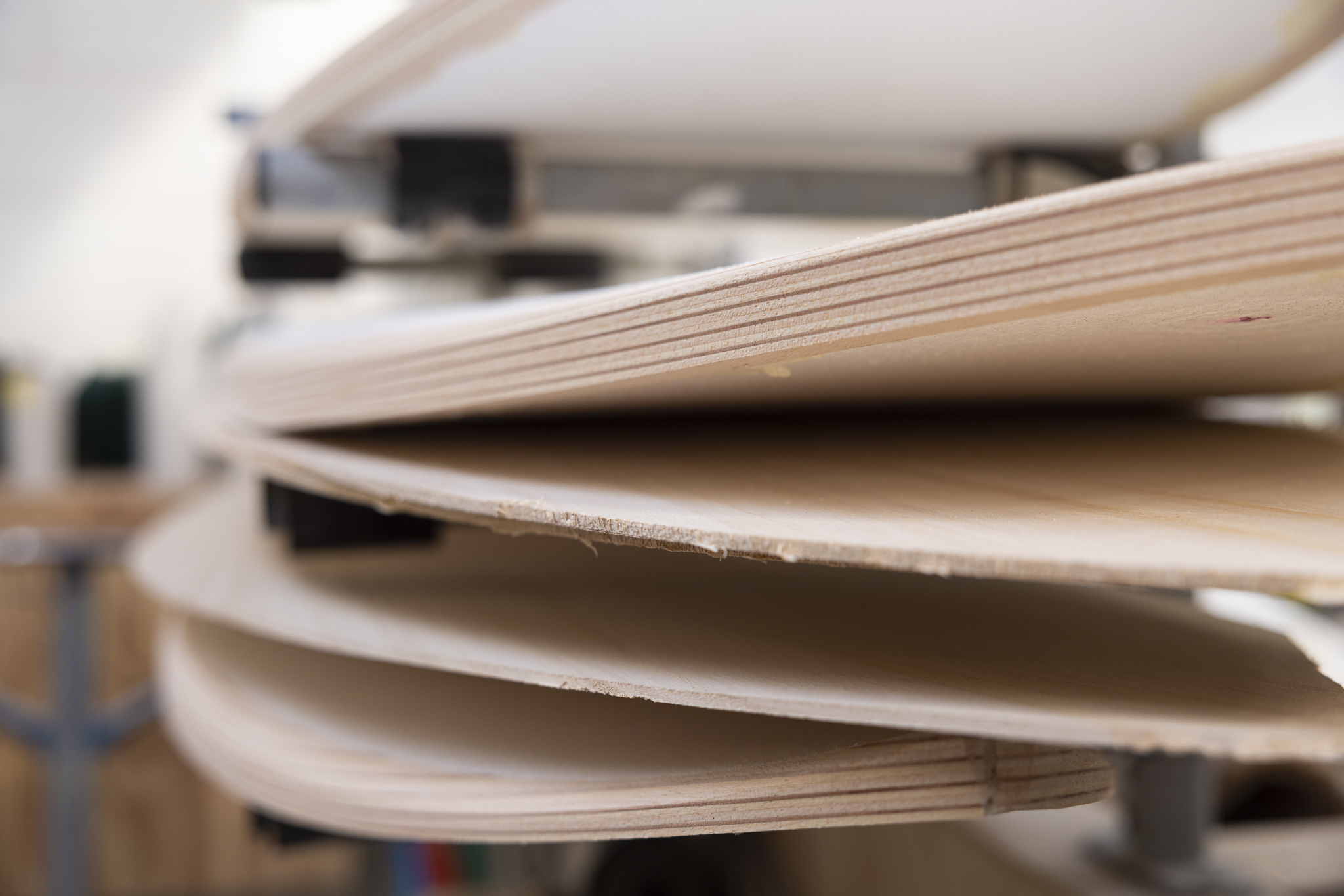
Jack believes the key to longevity is those parabolic rails that provide the flex in the first place. They might just be his secret ingredient, because he reckons they also make his boards ridiculously strong. Going back ten years and 800 boards, only three have been reported to snap. And two of those were experimental prototypes.
“The challenge is to make it flex and not snap. It’s a thin line, and finding it was the hard part,” Jack remarks.
We reckon he’s done a pretty good job finding the right balance between flex and strength – Verdure boards somehow have much greater, and longer lasting flex than PU boards, while resisting catastrophic failure in the form of a snap. He even offers a one-year extendable warranty against snaps. Now that’s confidence.
But Jack will be the first to point out that since his construction is relatively new, and given the limited testing, it’s hard to say for sure how durable his boards are. “At the moment, the verdict’s still out, because our latest construction has only been in the market for about a year. I’m pretty confident with where they’re at, and nobody has complained about the durability so far. But you do want to be at least five years down the line before you start making claims as to whether or not this is the ultimate method of producing a board, you know?”
At this point it becomes clear to me that one of Jack’s top business priorities is honesty and transparency. He’s hoping to do some testing on that hydrophobic oil to see how much faster they make his boards. He’s waiting to see how his boards perform over time before making claims about their durability. And he’s doing everything that he can to lessen the environmental impact of his boards, even though it’s already microscopic compared to most. It’s an honest business. Jack won’t hide anything from his customers. He’ll straight up tell you if he thinks you’d be better off with a traditional PU board. That’s what we love about his business. Surfers are attracted to his surfboards not because of some gimmick. They buy his boards because they surf well, last for ages, and leave behind a clear conscience.
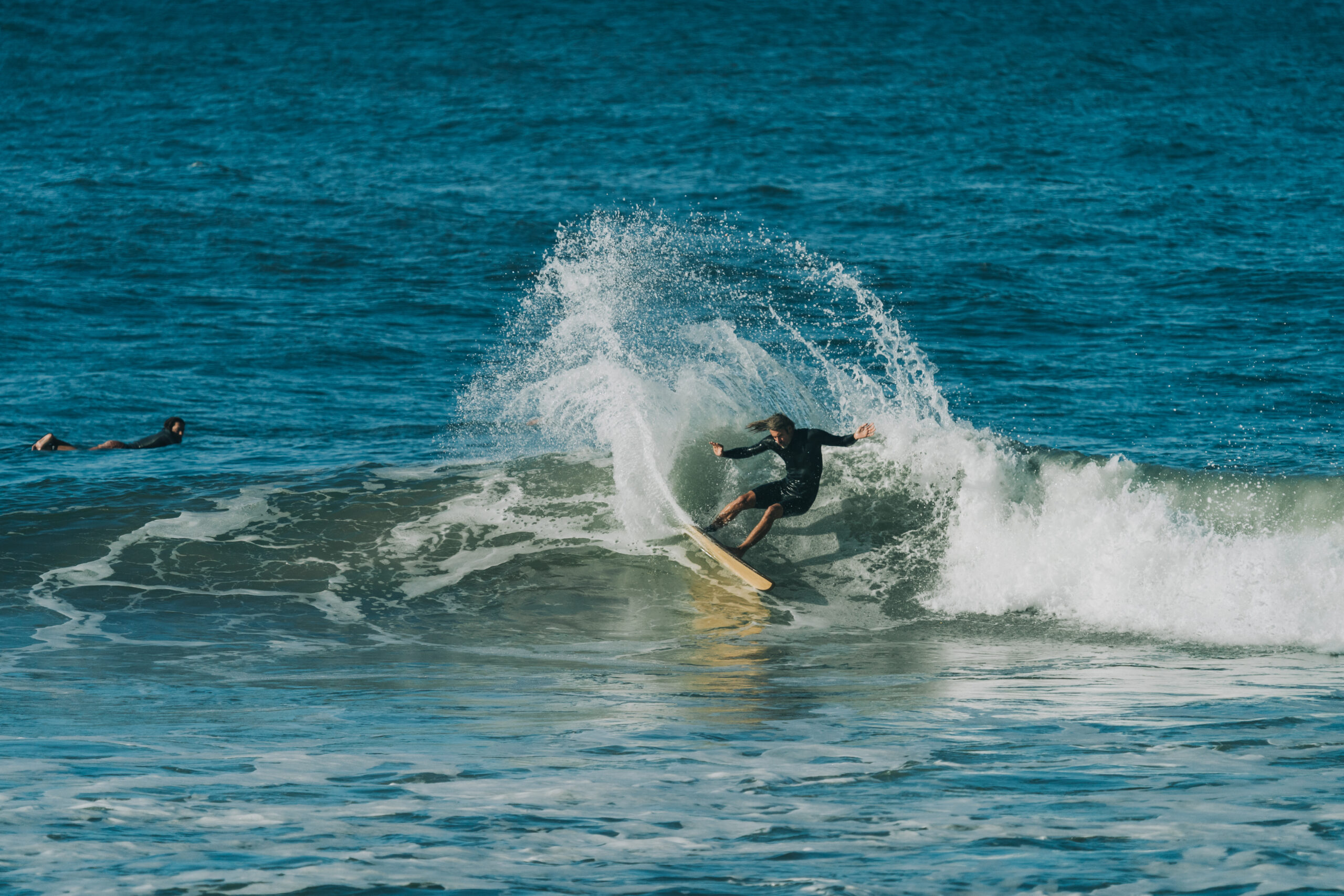
It seems like Jack has mastered the art of the sustainable performance surfboard. His next initiative? To share his technology with the surfing world. Over the years, he’s developed an ingenious board shaping machine to make his construction methods more affordable, efficient, and accessible. We walk through the factory until we reach a large silver box that resembles an oversized coffin.
“I used to call it the board former,” Jack laughs, “but honestly it’s better described as a reconfigurable rocker mould.”
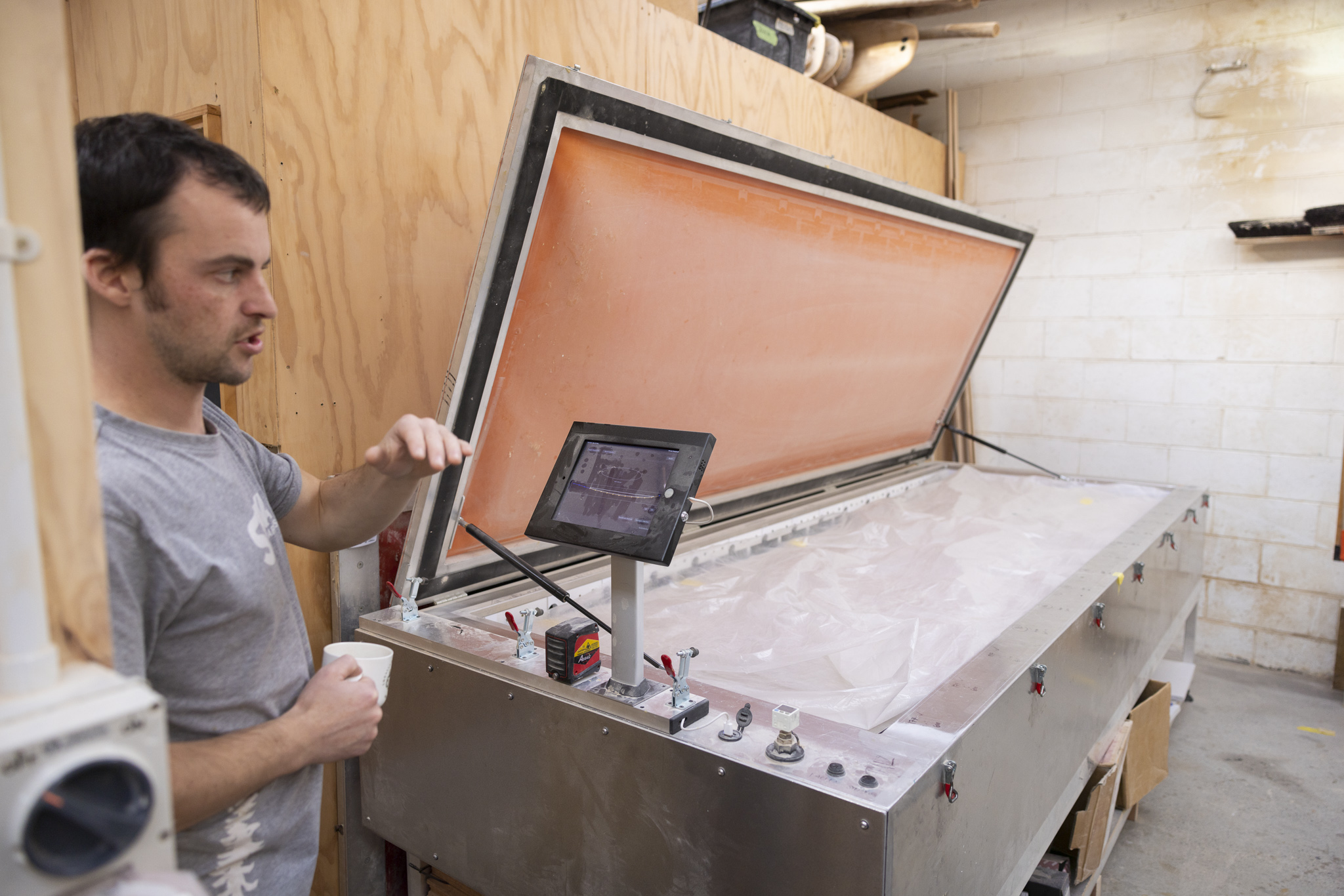
This creation has become the centerpiece of Verdure’s HQ, and is the keystone of Jack’s plan to make environmentally sustainable local surfboard manufacturing a possibility.
“Most people who build boards with alternative materials will make a rocker bed, and build the board on that,” Jack explains. “It’s basically a mould of the bottom contours and rocker to ensure the board doesn’t change shape. The problem with this is that most shapers want to do one-off customs. And it’s just not viable to make a unique mould for every board. If you look at those big Thailand manufacturers, they’re making hundreds of boards each month, so they’ve been able to play the mould game. Instead, I was interested in figuring out a way to enable local shapers to do one-off customs without having to make a unique rocker bed for each one.”
Jack waves his arm towards the large aluminium box. “And that’s what we’ve got here. Basically, it’s a big vacuum press, with an adjustable bottom plate that can adapt to create the profile bottom of each board. All our boards are built in this machine, and it’s accurate to about a millimetre. This allows us to build custom blanks for other shapers. They just have to send us their CAD file, and then we build them and ship them out, and they can offer our construction without any capital outlay.”
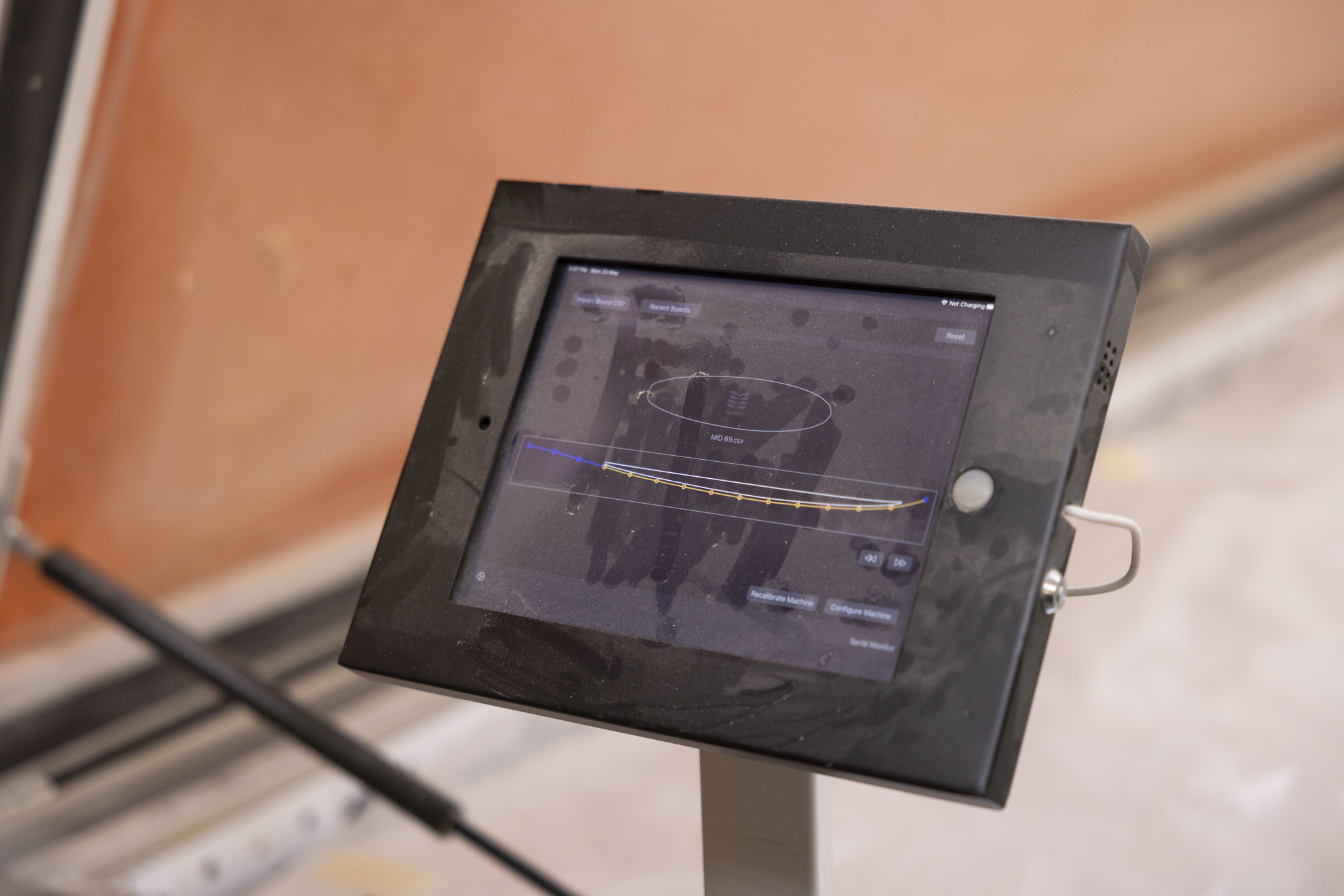
This invention is a great step towards making sustainable custom surfboards more accessible to shapers and surfers alike. Domestically, it’s been a huge success. But Jack has loftier goals that extend beyond the shores of New Zealand.
“New Zealand’s a pretty small market,” Jack explains. “We don’t have a massive industry here, or a lot of global influence. I’ve realised that it’s a great place to develop our products and figure things out, but it’s not the best place to launch products if you want to have a significant impact.”
In this sense, he understands his current operation as a pilot project before he spreads his technology globally. Eventually, he would like to establish a global infrastructure, allowing easy access to his blanks worldwide.
“So far, we’re setting up a factory in Byron Bay, Australia. I think within months they’ll be doing more business than we are doing down here. We’ve also licensed our technology to an existing manufacturer in Europe,” he offers. “That process is pretty simple. Once they buy the machines, I go over and teach them how to use it and build the blanks. And then we have an iPad app that runs the machines and logs how many boards they build. And then they pay a small royalty on each board they make.”
That royalty is quite small, and local shapers can still make good money on each board. In any case, Jack puts the royalty straight into further research, development, and marketing. The hope is that this licensing will establish that global infrastructure for producing his boards, and popularize locally made eco-friendly surfboards around the world.
“I’m hoping to get to a point where anyone in the world can buy a blank from us. We’ve got Europe and Australia, and we’re currently working on America, Japan, and Brazil among other countries.”
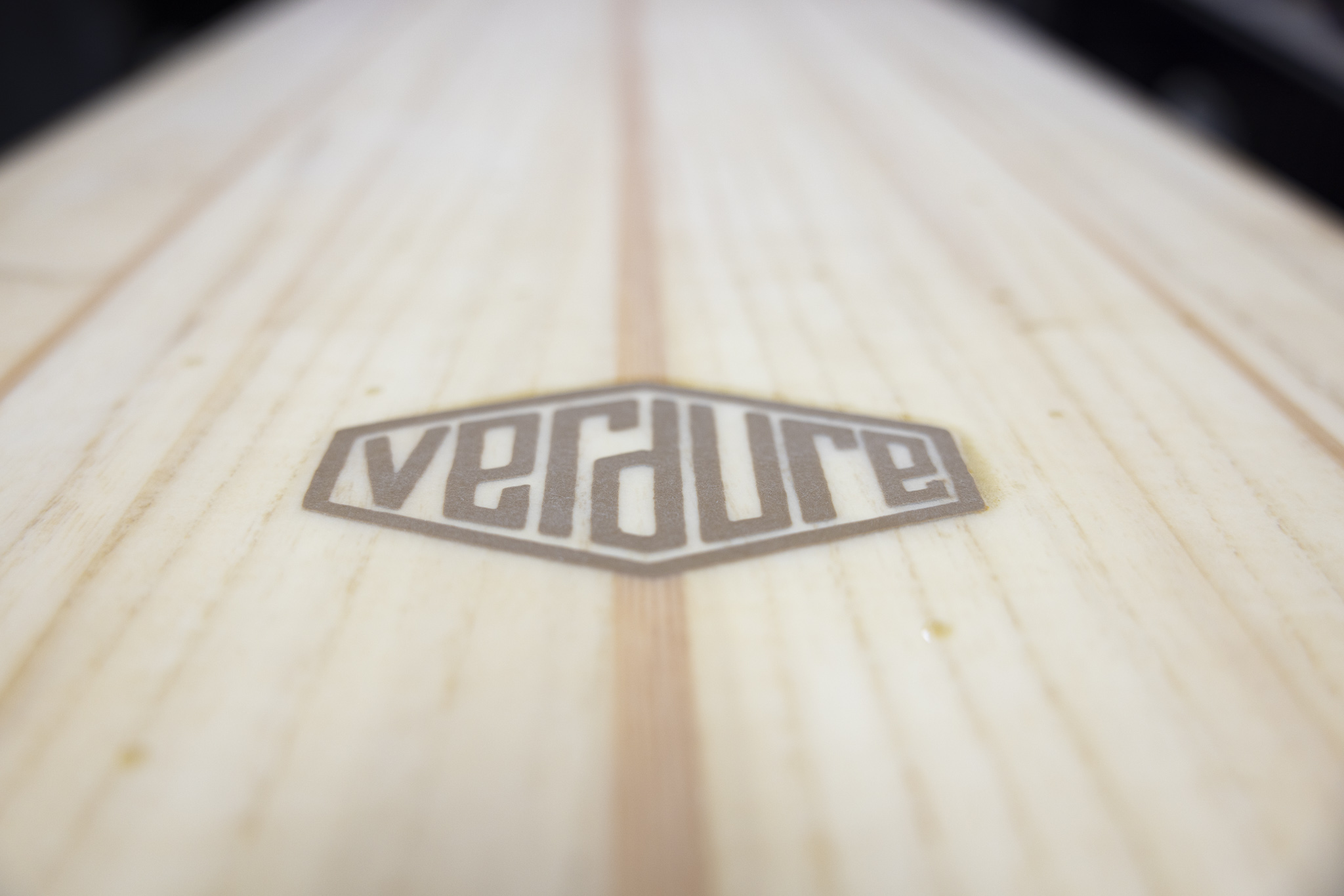
As far as Jack knows, he’s the only person to have built this kind of machine. “We have the only two in the world and we’re about to ship the third one, and then we’re going to build two more for Byron Bay. The cost of developing the technology was probably in the $300,000 range. So it is quite a big capital investment for someone to make, and it is a lot of boards before you start to pay that back,” he laughs.
But it’s worked well so far for Jack, and given the quality of his boards, it’s easy to believe that the initial capital investment will certainly pay off for the right shapers.
“Most of the time, people look at our boards and their first impression is quite skeptical. They think that they’re pretty weird,” he admits. “And then they ride them and they don’t wanna ride anything else. Except in small waves,” he laughs.
“The big challenge for anyone trying to develop a new surfboard construction is that it’s got to meet so many criteria,” he continues. “It’s gotta be commercially viable. It has to outperform PU. And on top of that, other factors like durability and sustainability complicate things. There’s just so many boxes to tick.” Jack grins. “But I think we’ve got a chance.”
It’s certainly a long road ahead for Jack if he wants to accomplish his goals of establishing an accessible sustainable surfboard industry worldwide. But his reconfigurable rocker mould is a massive step in the right direction. And when it catches on, Verdure’s blanks will be carving waves everywhere and preserving the environment along the way.
“The big challenge for anyone trying to develop a new surfboard construction is that it’s got to meet so many criteria. It’s gotta be commercially viable. It has to outperform PU. And on top of that, other factors like durability and sustainability complicate things. There’s just so many boxes to tick. But I think we’ve got a chance.”
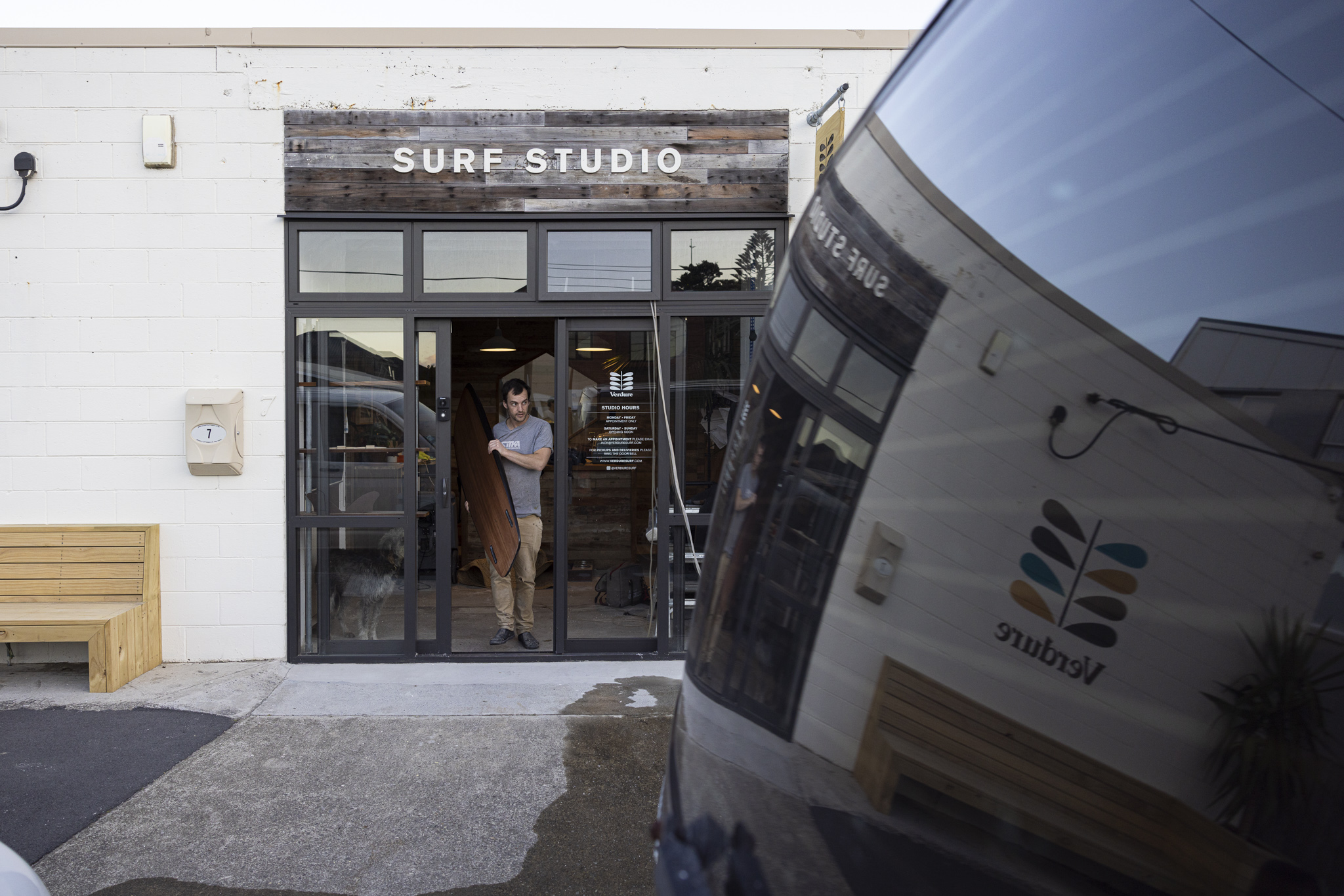
The first surfboards, crafted more than 1000 years ago in Polynesia, were made out of wood. Jack reckons we have something to learn from the first surfers, and that it’s time for surfing to return to its all-natural roots. That’s certainly no small task, and Jack will tell you that he’s still got a long way to go. He’s on the right trajectory, though, and once word spreads about Verdure Surf’s philosophy, it might just happen sooner than we all think.

